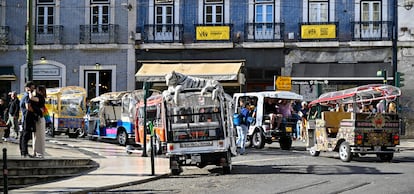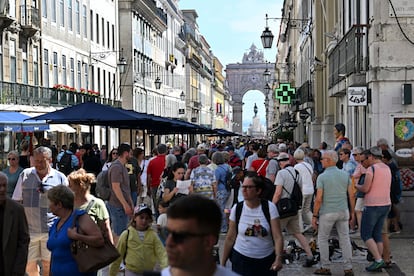Lisbon, a city dying from its own success
A traditional mix of authenticity, melancholy, rusticity and modernity, the Portuguese capital has become a mecca for international tourism. But it has paid the price in the form of gentrification and the loss of its essence

The symbol of Lisbon, romanticism aside, is the tuk-tuk. There are those with tigers on the roof, with plastic floral decoration, painted bubblegum pink, or disguised as a streetcar: any element that helps to stand out among the tide of tricycles ready to show thousands of tourists the five, 10, 15 or 20 things they should not miss in the Portuguese capital. The streetcar dominates on postcards and magnets, but the tuk-tuk has taken over the streets. When the two meet on the steep, narrow streets that climb up to the castle of São Jorge, historic collisions sometimes occur. The streetcars are rigid transports, incapable of deviating a millimeter from their route, while the tuk-tuks go at a brisk pace, often flouting traffic regulations to facilitate a good photograph and giving their passengers that frivolous, holiday-like feeling that they are in a carefree republic where everyone does what he or she wants. And so, without realizing it, Lisbon has joined the club of charismatic cities that now only make visitors happy.
“I think it has even stopped making tourists happy. There are people who came years ago and, when they have recently returned, they have found that it’s not the same,” says Tânia Correia. Lisbon was born in the place where Tânia grew up, the castle of São Jorge, a military fortress located on a hill overlooking the Tagus River that served as a protecter first of Islam and then of Christianity. On its slopes was built the Mouraría, a labyrinthine ghetto to house the Muslim inhabitants when the city was conquered by Afonso Henriques in 1147, and where now residents of 50 nationalities live together.
The Mouraría is one of the six historic neighborhoods belonging to the Junta de Freguesía de Santa Maria Maior (of 10,000 inhabitants). Six jewel-like neighborhoods (Castelo, Mouraría, Alfama, Chiado, Sé, and Baixa), steeped in history and culture, are now the favorite streets of real estate investors, tourist entrepreneurs, and tuk-tuk drivers. The cool Lisbon of hanging clothes, tiles, and colorful facades that last year was declared the best urban destination in Europe at the World Travel Awards. The Lisbon that has lost about 30% of its population since 2013. The Lisbon where 60% of the dwellings are tourist apartments. If the pace of the expulsion of locals does not stop, in a few years tourists will only be able to see each other when they climb the Alfama. Gentrification by leaps and bounds.

Amid the euro crisis, while the country was under intervention, the conservative government passed a law that allowed the updating of old rents and led to multiple evictions. In parallel, the entry of foreign capital was encouraged through aggressive tax policies (retirees from other countries moving to Portugal would not pay taxes until 2020), and the creation of golden visas, which provided legal residency to non-EU citizens in exchange for real estate investments. The Chinese became the most enthusiastic property owners in Lisbon. There was one good thing: the face of the city was rehabilitated and beautified. And a very bad thing: a massive exodus of Portuguese to the periphery.
“We lost population in the last 11 years because people were forced to leave, not only because of the great economic crisis, but because the right-wing government that was in place during the Troika years applied measures that allowed people to leave, and that also coincided with the entry on the scene of an apparently harmless activity, tourist apartments, which was deeply invasive for people,” says Miguel Coelho, president of the Junta de Freguesía de Santa Maria Maior.
Six historical neighborhoods have lost 30% of their population since 2013. Santa Maria Maior is coveted by real estate investors
Such was the impact of the so-called Cristas law, which liberalized rents without much consideration, that the board ended up developing the Faces of Evictions campaign, in which evicted residents told their story. Coelho believes that its repercussion served for the socialist government of António Costa to introduce some brakes and pursue real estate harassment. In 2018 it decreed a moratorium on saturated zones and a ban on opening more tourist apartments in Santa Maria Maior, although Coelho claims this is now being done illegally. In 2023, the government approved a series of restrictive measures for these businesses that will now be reversed in part by the new center-right administration.
Even so, the board intends to combat the exodus with a Return to the Neighborhood program, aimed at people who were forced to leave in the last 15 years. One of them could be Tânia Correia, who left the São Jorge neighborhood when the owners decided to sell the building she rented in. “I wanted to buy my apartment, but horizontal division was not permitted and the whole property had to be sold. When my contract ended, they didn’t renew me,” she recalls. Correia grew up in one of the houses built inside the walls of São Jorge castle, where she also wanted to see her son grow up. Although five years ago she had to move to Buraca, on the outskirts of the capital, and now has to commute an hour on public transport to get to her job at a multinational insurance company in downtown, the castle is still her neighborhood. Her mother, who now knows only a few of her neighbors, remains there. “I can understand that we need to sell our country to capitalize it because we are poor, but it can be sold to attract luxury tourism and not low-cost tourism,” she adds.

The law prevents the eviction of elderly residents, but everything else is market-driven. Where once there were tenement houses there are now tourist apartments. Where there used to be the mercearia, the old-fashioned grocery store, there is now a modern bar. Community life, which was structured around the school, small businesses, and neighborhood associations, is languishing, although the nostalgic diaspora return every weekend.
In 2023 Portugal received more tourists (30 million) and revenues (€25 billion) than ever before. And Lisbon is a must-stop, one of those cities that have gained charisma as much by the real — its geographical and urban uniqueness — as by the imaginary. If it is a city mourned, longed for, loved, and recreated by Amália Rodrigues, Fernando Pessoa, Antonio Tabucchi or Antonio Muñoz Molina, how can it not captivate the 700,000 cruise ship passengers who last year took a quick tour to taste a port, photograph Liberty Avenue from the top of Eduardo VII Park, and be dazzled by the reflections of the sun on the tiles?
Visitors now enter new stores made to look like old ones as the real ones disappear. Casa Senna recently closed after 189 years of operation in Chiado, as did the Ferin bookshop. Being one of the most beautiful and the second oldest — it was founded in 1840 — did not save it from disaster. In the disputed heart of tourists there is only room for one historic bookstore. And none, no matter how old, can compete with Bertrand, opened in 1732 and therefore, according to Guinness, the oldest bookstore in the world. A few meters away, the historic Paris in Lisbon, which offers linen and cotton table and bed linen, has put up a sign to warn groups not to crowd in front of its shop window. Opened in the 19th century, it is one of the few traditional stores still standing in the Chiado, amid the fever of stores selling pastéis de nata, magnets, and pastéis de bacalhau.
When I go to Baixa or Chiado, I feel like I’m in an amusement park for foreigners. Almost everything is international brand stores or souvenir stores. Tourism has decimated everythingPedro Martins Barata, president of the Academia de Amadores de Música
Vintage is on the rise as a decoration for tourists. The traditional has been displaced. Bad times for a cultural institution like the Academia de Amadores de Música, founded in 1884 in the center of Lisbon and forced to leave its current headquarters on Rua Nova da Trindade within a year. After dodging the effects of the Cristas law for a decade, the owners took advantage of a loophole in 2023 to raise the monthly rent from €540 to €3,800. “Only with a patron could we afford the rents in the area,” maintains its president, Pedro Martins Barata.
The Academy is part of Lisbon’s cultural and political history. Among its members were writers José Saramago and José Cardoso Pires, and among its professors, great composers. Perhaps without the Academy there would not have been Madredeus, the group that triumphed all over the world with its vindication of a traditional music outside of fado, since both vocalist Teresa Salgueiro and guitarist Pedro Ayres Magalhães were trained at the school.
Like people, institutions and businesses related to culture are also pushed to the periphery. Barata loves his city but no longer recognizes it: “When I go to Baixa or Chiado, I feel like I’m in an amusement park for foreigners. The idea of Chiado as the center of Lisbon’s cultural life has disappeared. Except for the theaters and museums, which cannot be altered, almost everything is international brand stores or souvenir stores. Tourism has decimated everything.”
Sign up for our weekly newsletter to get more English-language news coverage from EL PAÍS USA Edition











































